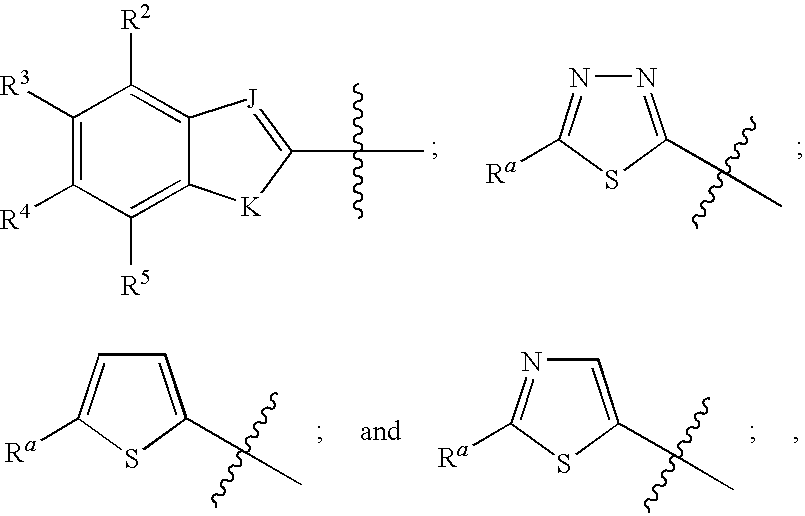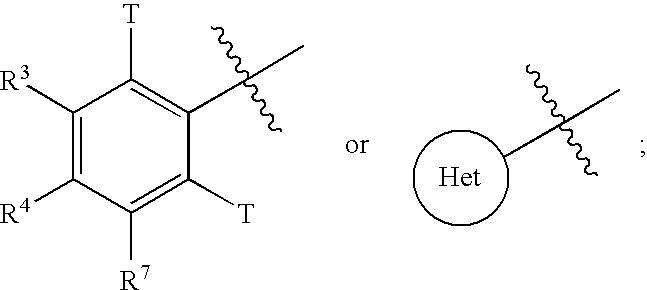Novel sulfonamidomethylphosphonate inhibitors of beta-lactamase
a technology of methylphosphonate and beta-lactamase, which is applied in the direction of antibacterial agents, active ingredients of phosphorous compounds, drug compositions, etc., can solve the problems of increased treatment cost, increased hospital stay, and increased mortality, so as to prolong the antimicrobial activity spectrum and synergize the antibacterial
- Summary
- Abstract
- Description
- Claims
- Application Information
AI Technical Summary
Benefits of technology
Problems solved by technology
Method used
Image
Examples
example 35
Preparative Example 35
DIMETHYL (5-FORMYLBENZO[b]THIOPHENE-2-SULFONAMIDO)-METHYLPHOSPHONATE
[0387]To a solution of dimethyl (5-vinylbenzo[b]thiophene-2-sulfonamido)methylphosphonate (0.45 g, 1.25 mmol) in THF (75 mL) was added osmium tetroxide (4% in water, 0.1 mL), and sodium periodate (0.70 g, 3.3 mmol) in water (10 mL). This mixture was stirred for 24 h at r.t. and concentrated. The residue was extracted with ethyl acetate; the organic extract was washed with water and brine, dried over magnesium sulfate, and concentrated. Column chromatography (ethyl acetate as an eluent) provided the pure product.
[0388]1H NMR (400 MHz, DMSO-d6) δ (ppm): 10.10 (s, 1H); 8.74 (br s, 1H); 8.58 (d, J=1.6, 1H); 8.30 (dd, J=8.4, 0.6, 1H); 8.23 (d. J=0.6, 1H); 7.98 (dd, J=8.4, 1.6, 1H); 3.63 (d, J=10.8, 6H); 3.38 (d, J=12.1, 2H).
example 36
Preparative Example 36
Method A. Preparation of [({[5,6-BIS(2-AZIDOETHOXY)-1-BENZOTHIEN-2-YL]-SULFONYL}AMINO)METHYL]PHOSPHONIC ACID
[0389]A stirred mixture of phosphonic acid (110 mg, 0.24 mmol) and NaN3 (62 mg, 4 equiv) in DMSO was heated at 80° C. for 16 h. The reaction mixture was cooled to room temperature and then purified by reverse phase HPLC to afford the product.
[0390]1H NMR (400 MHz, CD3OD) δ (ppm): 7.82 (s, 1H), 7.55 (s, 1H), 7.5 (s, 1H), 4.3 (m, 4H), 3.7 (m, 4H), 3.25 (d, 2H); MS m / z 478 (M+1).
[0391]Utilizing the foregoing procedure, the following compounds were prepared:
{[({5-[3,4-bis(3-azidopropoxy)phenyl]thiophen-2-yl}sulfonyl)amino]methyl}phosphonic acid was prepared and purified by reverse phase HPLC.
[0392]1H NMR (500 MHz, CD3OD) δ (ppm): 7.60 (d, 1H), 7.38 (d, 1H), 7.24 (m, 2H), 7.04 (d, 1H), 4.20 (m, 4H), 3.60 (m, 4H), 3.10 (d, 2H), 2.10 (m, 4H); MS m / z 532 (M+1).
{[({5-[3,4-bis(3-azidopropoxy)-2-methylphenyl]thiophen-2-yl}sulfonyl)amino]methyl}-phosphonic acid was p...
example 37
Preparative Example 37
Preparation of 4-CYANO-3-FLUOROPHENYL HYDROGEN {[({5-[3,4-BIS(3-AZIDOPROPOXY)PHENYL]THIOPHENE-2-YL}SULFONYL)AMINO}METHYL}PHOSPHONATE
[0411]A mixture of the phosphonic acid (0.2 g, 0.38 mmol), 2-fluoro-4-hydroxybenzonitrile (0.077 g, 1.5 equiv), and trichloroacetonitrile (380 uL, 10 equiv) in a solvent mixture of 2.0 mL of anhydrous pyridine and 0.2 mL of DMF in a sealed tube was heated at 105° C. for 6 h. The reaction mixture was concentrated and used as is in the next step.
[0412]MS m / z 623 (M−28).
[0413]Utilizing the foregoing procedure the follow compounds were prepared:
4-cyano-3-fluorophenyl hydrogen {[({5-[3,4-bis(3-azidopropoxy)-2-methylphenyl]thiophen-2-yl}sulfonyl)amino]methyl}phosphonate was prepared and used as is in the next step.
[0414]MS m / z 637 (M−28).
4-cyano-3-fluorophenyl hydrogen {[({5-[4,5-bis(3-azidopropoxy)-2-methylphenyl]thiophen-2-yl}sulfonyl)amino]methyl}phosphonate was prepared and used as is in the next step.
[0415]MS m / z 637 (M−28).
4-cyano-...
PUM
| Property | Measurement | Unit |
|---|---|---|
| Volume | aaaaa | aaaaa |
| Volume | aaaaa | aaaaa |
| Mass | aaaaa | aaaaa |
Abstract
Description
Claims
Application Information
 Login to View More
Login to View More - R&D
- Intellectual Property
- Life Sciences
- Materials
- Tech Scout
- Unparalleled Data Quality
- Higher Quality Content
- 60% Fewer Hallucinations
Browse by: Latest US Patents, China's latest patents, Technical Efficacy Thesaurus, Application Domain, Technology Topic, Popular Technical Reports.
© 2025 PatSnap. All rights reserved.Legal|Privacy policy|Modern Slavery Act Transparency Statement|Sitemap|About US| Contact US: help@patsnap.com



